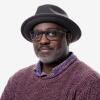‘Watchmen’ countdown: Peter Travers and the effects
This article was originally on a blog post platform and may be missing photos, graphics or links. See About archive blog posts.
The visual effects are, to many, the front lines of success in tentpole movies like ‘Watchmen.’ Peter Travers, then, is a bullet-stopper, having been in the trenches with ‘Lord of the Rings: Two Towers,’ ‘The Matrix Reloaded,’ ‘Harry Potter and the Sorcerer’s Stone’ and more. We got to ask ‘Watchmen’s’ visual effects supervisor a few questions about his latest war.
We’re you a fan of the book beforehand?
No! Not that I wasn’t a fan of it, I had just never heard of it, and I was a comic book kid. It came out at the time when I had moved on from comic books. You know, I was into Marvel and ‘Fantastic Four’ and things like that in the ‘70s. This thing came out in the ‘80s and I had already moved on. But then, as I hear about the project, I was handed the comic book. I read it and I was very impressed. And then I started to hear from other people, and I didn’t realize just how much of a following the graphic novel has, and the people that have read it are zealous fans. It’s a blessing and a curse when you’re making a movie. ... You’ve got to make sure that you please the ardent fans. I think that Zack, the director, he understood ‘Watchmen’ probably more than anybody. From what I hear, people are saying that it’s extremely faithful.
So, we’ve all heard about the panel for panel production, but was it really that tight?
It literally was a part of our storyboards. Zack did all of his storyboards, but there was always a supplemental storyboard when we would get our sheets. We’d have our notes and stuff from Zach, but then at the bottom, would be a direct panel from the comic book. And certainly, even in the post production, we’d always be looking back.
When Billy gets destroyed the first time, and I never noticed it, but there’s a curvature to the flames in the graphic novel. And we looked back at it, and D.J., the overall visual effect supervisor, said let’s do it like this. And we were like, OK. So it wasn’t like the graphic novel went away after a while, it was always there.
When you did ‘Lord of the Rings,’ it seemed that the effects were not as intrinsic to the story. Here, they seem like they’re a big part of the story. Do you set everything up differently with that storytelling aspect in mind?
Yeah, that always plays a part. I don’t think ‘Lord of the Rings’ was any less of a challenge in that respect. There was certainly a faithfulness there as well. In particular, when you’re doing this type of work, there are certain types of task specifications -- not to get too technical here -- that a character has to do or achieve, and that does affect the design. Doc’s eyes are kind of pale white, and that works fine in the comic book, but when you translate that to the movie ... if you can’t read his eye direction, would that work in a movie? He would come off almost as like some kind of blind character ... so that directly affected the look of him.
Was there a shot that you created that you didn’t get to use?
No. And I’ll say this ... I think there are many things that are impressive about Zack Snyder, but he was incredibly efficient. There were close to 200 sets that were shooting. So, to coordinate all that and get what you want, I think that’s an incredible challenge. And Zack pulled it off. It was amazing what he did.
Was there anything you did that you got an unexpected reaction from?
Not really. I think the reactions from people are the same reactions as our crew here. ... Probably more than any set I’ve worked on, the really pain-in-the-butt shots that were really hard and labor-intensive were also the most rewarding [in the film]. In particular, I would say that the New York City destruction, there’s a wide shot looking down on New York City, and simulation-wise, it was incredibly intense, computationally. You think about trying to figure out how to tear buildings apart. ... I mean, the math was pretty up there. It’s very believable-looking.
What did you take from this that you’re going to add to your next project?
I learned a lot about animation and I think that the way the design ...you can, in a way, call what we did for Doc, a motion-capture setup. ... We came up with the idea of using witness cameras, and everything was synced ... but the point was, while the director set up the shot and the lighting, we would slip into whatever space we could and capture Billy’s performance. .... The point was that were able to get everything we needed and get out of everybody’s way.
It was interesting to me to have some input on the front end, and to see it through to its fruition was very rewarding.
-- Jevon Phillips
